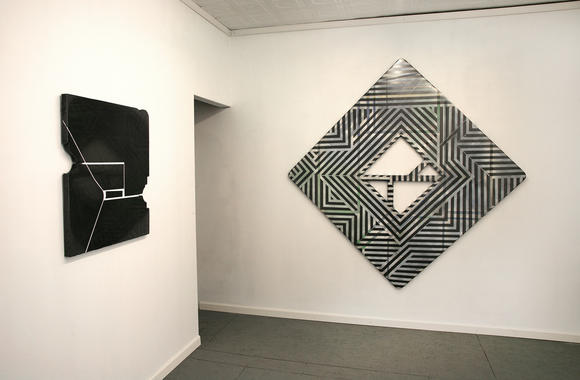An Open Letter from The McKeldin Fountain, shared by BmoreArt
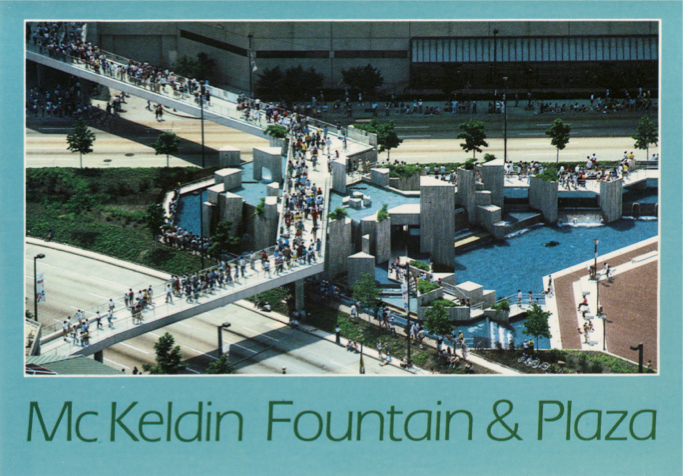
History
The Fountain in McKeldin Plaza was designed by Thomas Todd of Wallace, Roberts, & Todd. Intended to be the centerpiece of their Harbor Place plan, the Fountain was a physical link from the hotels and convention centers downtown, to the pavilions at the redesigned waterfront. The Fountain allowed visitors to occupy it and walk safely above the traffic on Light Street. Conceptually, the Fountain was also meant to imply a connection to the angular concrete forms of the Mechanic Theater a few blocks away at Charles Center, which had just been renovated and re-opened when the Fountain was dedicated in 1982.
The Fountain and Plaza were named to honor Governor and former Mayor Thomas McKeldin, an early champion of integration in Baltimore City, and an early proponent of redevelopment at the Inner Harbor. The forms of the fountain, with water splashing down from pool to pool as users climb up to the skybridge, was, according to its creators, meant to recall the source of the Cheasapeake Bay at the head of the Susquehanna River. The original name of the Fountain is ‘The Waterfall’, a plaque on its side commemorates that it was “Provided through the Generosity of Mr. and Mrs. Harvey A. Meyerhoff and the Citizens of Baltimore.”
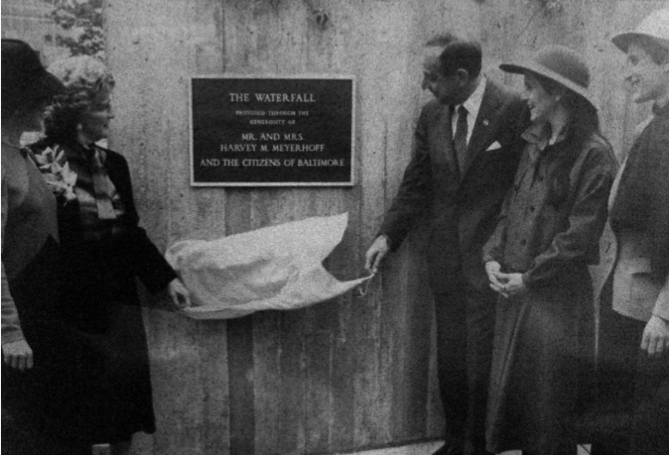
Pratt Street Initiative
On September 9th, 2008, Architecture firm Ayers Saint Gross (ASG), in conjunction with landscape architecture firm Olin Partnership, released a document titled ‘Pratt Street: Avenue of the Inner Harbor | Concept Development’ (1). This was the culmination of a process that begun with a design competition in late 2006. Six teams were asked, by the Baltimore Development Corporation (BDC) and the Downtown Partnership of Baltimore (DPoB), to submit proposals for the redesign of Pratt Street downtown (2).
In the document’s Introduction, under a subsection labeled ‘Prominent Near-Term Improvements’, the plan’s intentions for McKeldin Plaza are laid out:
The design recognizes the intersection of Pratt and Light Street as having the potential to make the biggest impact in terms of public space creation. McKeldin Plaza should be merged with the parkland at Harborplace, creating a larger, more attractive plaza that connects the City to the water, not traffic. Accordingly, the angled lane of traffic on Light Street (where it intersects with Pratt and Calvert streets) will be eliminated and all north-bound traffic will intersect at the main corner of Pratt and Light streets. The new McKeldin Plaza will function as a civic gathering space, as well as a passive recreation area and include a fountain similar to that of Centennial Park in Atlanta.
The document shows several renderings and plan views of McKeldin Plaza without McKeldin Fountain, but the Fountain, or its destruction, is not mentioned by name anywhere in the text.
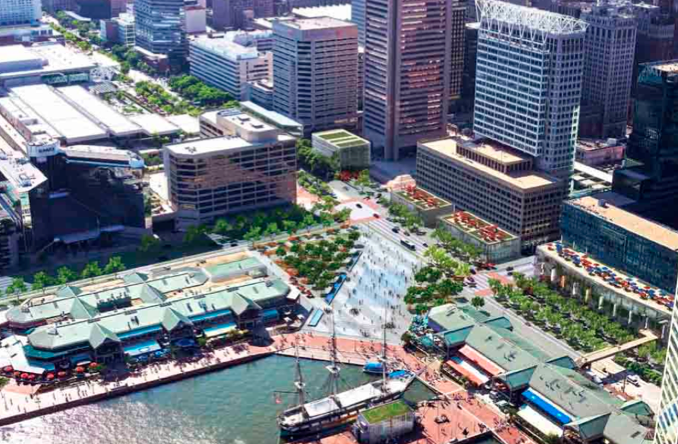
On the 18th of September, nine days after the plan’s release date, it was presented to the Baltimore City Department of Planning’s Urban Design and Architecture Review Panel (UDARP)(3). The Panel expressed disappointment that the original intention to make Pratt Street into a two way corridor had been dropped. While the group praised the decision to connect McKeldin Plaza and remove the traffic lanes, they were concerned that the existing proposal to replace the Fountain with a linear water feature made destruction worthwhile: “will the water jets be better than the current fountain?”
Current Proposal
In 2014, six years after the most recent public meeting, the Downtown Partnership has a new proposal for the Fountain’s replacement, an empty green lawn. The closure of the Light Street spur to Pratt Street, the reconnection of the Plaza to the rest of Harbor Place, is indefinitely deferred under the new plan.
Downtown Partnership President Kirby Fowler told the Baltimore business Journal: “The whole Pratt Street Initiative has been a series of piecemeal changes that in total have made a difference, and I think it’s time to start on the McKeldin project even if the whole thing hasn’t been funded.” (4) Instead of the expanded Plaza and replacement water feature, the renderings released by DPoB show a triangular patch of grass.
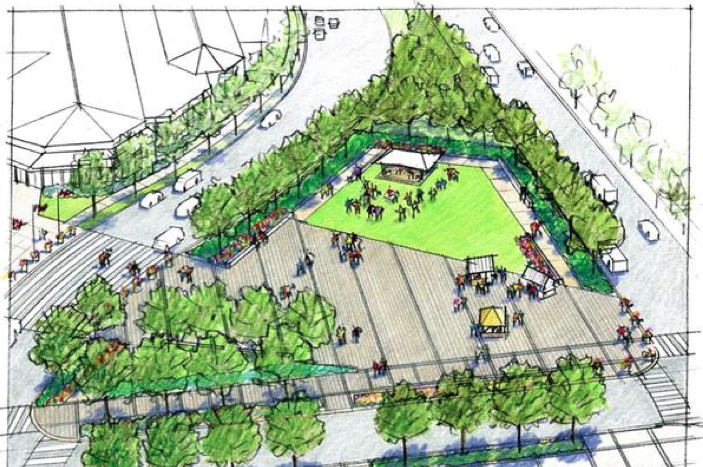
The new proposal, without Plaza connections or traffic improvements, has not been presented to the Urban Design and Architecture Review Panel. DPoB President Kirby Fowler told the Baltimore Business Journal, in June 2014, that plans were moving forward to destroy the Fountain: “The sooner we can take it down the better.” (5) Fowler and DPoB report that they’ve raised commitments of around $1 million from corporate donors, foundations, and Baltimore City. They estimate that total cost for demolition and construction of lawn above would be $3.5 million (6).
In the earlier Pratt Street plan, from ASG and Olin Partnership, the reconstruction of the Plaza is part of Phase One, which had been scheduled to begin in 2009. The cost for the reconnected McKeldin Plaza is estimated at $24.4 million, while Phase One overall is listed at over $44 million. The cost for demolition isn’t listed, but there is a $1.3 million line item listed for “Site Preparation” at McKeldin Plaza. There is no specific budget line item for the destruction of the Fountain. When it was under construction in 1981, the Baltimore Sun reported that the Fountain cost $3.6 million (7), this is equivalent to $10.4 million in today’s dollars.

Maintenance and Ownership
The Fountain is currently owned by the Baltimore City Department of Recreation and Parks, and maintained by the Department of Public Works. In the summer of 2014, it was briefly shut down for repairs, but it is scheduled to run for the six warmer months of the year. The Fountain was designed and built with heating included, to allow it run year-round. This is no longer used. Nor are many of the light fixtures that are cast into its concrete volumes, intended to light the Fountain dramatically at night. The Fountain is cleaned regularly, and graffiti is removed as soon as it is reported, as is the case with all city-owned property.

Against Demolition
The geometry of the Fountain’s layout links several aspects of the Inner Harbor together. The Fountain’s angles and materials are reflected in the plan of the Harbor Place pavilions and promenade, the Hyatt Regency across Light Street, and Transamerica Building across Pratt Street. The Fountain is formally the heart of the composition of this area between downtown Baltimore and the Harbor. Functionally, the Fountain and the skywalks associated with it still serve their original purpose, allowing pedestrians to access the waterfront amenities without having to cross the streets in an area that is given over to very busy car traffic.
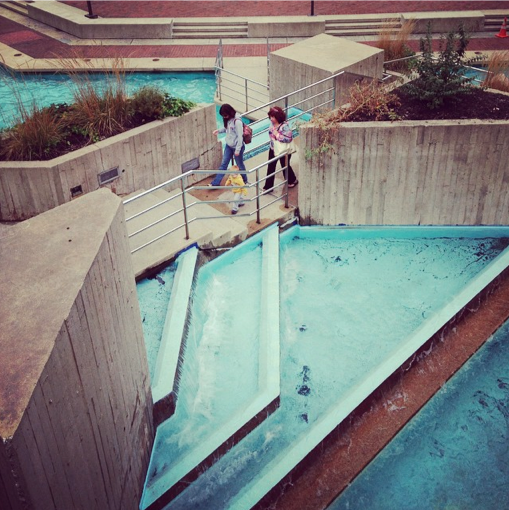
AIA Baltimore president Tom Leibel, and executive director Kathleen Lane, issued a joint statement to the City Paper regarding the Fountain’s destruction: “The problem isn’t the fountain. The problem is the traffic circulation around McKeldin Plaza. If the fountain is demolished, and the traffic issues are not addressed, then the problem will not have been solved.” (8) By forcing all pedestrians to cross the two branches and ten lanes of Light Street at grade, the destruction of the Fountain will likely make the traffic situation even worse for both those on foot, and in cars.
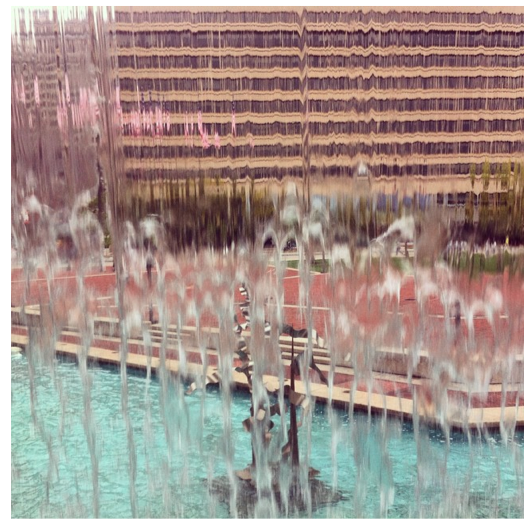
The Fountain is a rare example of public art that is both functional and occupiable. It is not meant to be simply viewed, but used and explored. Visitors can walk above and even underneath the cascades of water. Its unique material and geometry make it a destination for younger generations of people looking for new forms of expression and even protest in the City.
Diverse groups, from the practitioners of the alternative running performance known as Parkour (9), to Otakon, the yearly anime and science fiction enthusiast convention (10), to Occupy Baltimore (11), who camped in the Plaza to raise awareness of economic and social inequality, have recognized the unique value of the Fountain. Otakon attendees have even created an online petition against the Fountain’s destruction.
As Jennifer Goold, former development professional, and current executive director of the Neighborhood Design Center, told the Baltimore Business Journal: “The fountain represents the optimism of recapturing our waterfront in the midcentury.”(13) As public art, and as public amenity, any proposal to destroy it should be examined very carefully by Baltimore City agencies like the Public Art Commission, and the art and design communities, before a decision is made.

At the time of this writing, an online poll conducted by the Baltimore Business Journal about the destruction of the Fountain, with nearly a thousand total votes, shows a clear majority of their readers are against it (14). 47% of poll respondents say they want the Fountain to stay no matter what, 29% percent say that the park shown in the DPoB rendering isn’t good enough, and ask for a ‘grand plan’, only 25% of people voting in the poll say the Fountain should go.
The demolition of any monument is not simply a negative act. The destruction of architecture or public artwork is also the creation of a new thing, which is the absence of what was there before. The Fountain is a unique piece, and whether its replacement is what Downtown Partnership has called a “basic water feature”, or an empty patch of grassy park, once demolition begins, the Fountain ends. The construction of the Pratt Street initiative has a mandate, but at a cost of over $40 million, it is an unfunded one. The destruction of the Fountain, without improvements to traffic, and without any worthwhile replacement, may be partially funded, but it doesn’t have a mandate.
Regardless of any opinion about the Fountain’s worth, there is no value in demolishing it until the traffic issue is resolved and a completed and publicly approved design is funded. The decision to destroy the Fountain should be given the full attention of City residents, planners, government, and visitors. It should not be assumed that because it was a small, barely mentioned portion of a long term redevelopment plan, that proper attention to this decision has been offered, and that the process is over. If you agree, please pass on, share, and cosign this open letter.
Sincerely,
The McKeldin Fountain November 2014, Baltimore
For more information about how to get involved, email The McKeldin Fountain herself at [email protected] or via Twitter at twitter account: @mckdnfntn.
You an also reach out to Kirby Fowler at the Downtown Partnership to let him know that you want this fountain to stay: [email protected]. Or, you can get in touch with members of the Public Art Commission or your City Councilperson.
Footnotes:
1 http://www.baltimoredevelopment.com/assets/files/1/files/print_materials/ misc/pratt_street_plan-.pdf
2 http://www.bizjournals.com/baltimore/stories/2006/12/11/daily29.html
3 http://ca.baltimorecity.gov/filebrowser/udarp/2008/09-18- 08/Pratt%20Street%20Continued%209-18-08.pdf
4 http://www.bizjournals.com/baltimore/blog/real-estate/2014/06/inner- harbors-deteriorating-mckeldin-fountain-is.html
5 http://www.bizjournals.com/baltimore/blog/real-estate/2014/06/inner- harbors-deteriorating-mckeldin-fountain-is.html
6 http://www.bizjournals.com/baltimore/news/2014/09/25/downtown- partnership-sets-a-target-for-mckeldin.html
7 “‘Water to sparkle and splash in city’s ‘mountain spring’”, Carleton Jones, May 10, 1981, The Baltimore Sun
8 http://www.citypaper.com/news/mobtownbeat/bcp-brutal-reckoning- 20141014,0,2894060.story
9 http://articles.baltimoresun.com/2014-09-24/news/bs-ed-parkour-mckeldin- fountain-20140924_1_parkour-traceurs-mckeldin-fountain
10 http://board.otakon.com/index.php?showtopic=26334
11 http://en.wikipedia.org/wiki/Occupy_Baltimore
12 https://www.change.org/p/city-of-baltimore-stop-the-tearing-down-of-the- mckeldin-fountain
13 http://www.bizjournals.com/baltimore/blog/real-estate/2014/10/as-mckeldin- fountain-nears-demolition-some-have.html
14 http://www.bizjournals.com/baltimore/pulse/poll/should-the-inner-harbors- mckeldin-fountain-be-demolished/15719641

